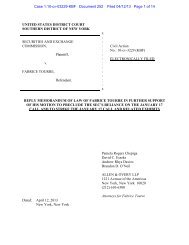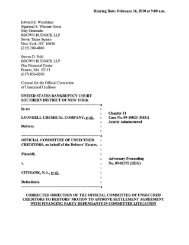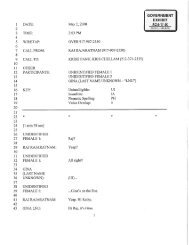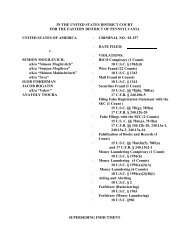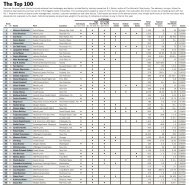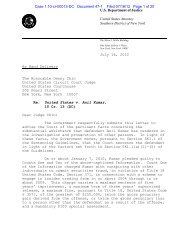Salz Review - Wall Street Journal
Salz Review - Wall Street Journal
Salz Review - Wall Street Journal
Create successful ePaper yourself
Turn your PDF publications into a flip-book with our unique Google optimized e-Paper software.
<strong>Salz</strong> <strong>Review</strong><br />
An Independent <strong>Review</strong> of Barclays’ Business Practices<br />
138<br />
Retail Incentive Schemes<br />
11.32 Many retail staff participate in branch network incentive schemes. 219 These<br />
employees are not eligible for a discretionary bonus. For them, incentives comprise a<br />
relatively small (approximately 11% for UK Personal Bankers in 2012) portion of<br />
total compensation, although a few staff achieved relatively high bonuses in relation<br />
to salary. Research shows that even incentives of relatively small magnitude impact<br />
employees’ behaviour – good and bad.<br />
11.33 Prior to 2007, the Barclays UK RBB sales force worked under a discretionary bonus<br />
scheme where points were allocated for each type of product sold. After 2007, the<br />
scheme linked bonuses formulaically to individual sales performance, with different<br />
incentive payments for each product sold; for example, as we noted earlier in the<br />
report, loans sold with PPI had an incentive value of two and a half times that of a<br />
loan without PPI. Over time, additional customer service elements were added,<br />
although a number of sales focused features remained in place through 2012 – most<br />
notably an “accelerator” 220 feature that disproportionally increased the value of<br />
incentive payments as an individual sold more.<br />
11.34 There has been much debate on the moral hazards of basing the incentives of a retail<br />
bank sales force on achieving sales volumes thereby underemphasising customer<br />
needs and suitability. We have concluded that the sales focus of the incentive<br />
schemes in place at UK RBB and Barclaycard were likely to have contributed to<br />
alleged mis-selling of certain products, such as PPI. Incentive schemes signal what<br />
matters to management – and so how staff should behave in order to be regarded<br />
as successful.<br />
11.35 A new retail incentive scheme was introduced by Barclays in the UK in December<br />
2012. 221 It is focused on customer satisfaction, with no direct link to sales. This move<br />
is intended by management to put Barclays ahead of many peers in encouraging<br />
greater customer focus. Importantly it also puts significantly greater emphasis on<br />
collective efforts; customer satisfaction is measured at a branch and area level – there<br />
are no individual key performance indicators (KPIs). This is an encouraging step in<br />
reinforcing appropriate behaviours in the branch network.<br />
11.36 The new incentive scheme may need to evolve further still. Currently it is not well<br />
aligned to the bank’s people management tools. For example, performance objectives<br />
are not well reflected in pay structures (the objectives are based on five dimensions 222<br />
but incentives are based only on customer service). Sales incentives may have gone,<br />
but it appears that sales targets still exist at both a branch and individual level (either<br />
formally or informally). Such contradictions need addressing. If staff see sales targets<br />
(such as internal branch league tables) to be important, removing sales-based<br />
incentive pay may not succeed in changing individual behaviour. Narrowly defined<br />
219 Some staff in contact centres also participated in sales incentive schemes.<br />
220 The ‘Accelerator’ in Barclays’ retail incentive schemes resulted in commission payments per product sold<br />
increasing as an individual’s sales increased during a month.<br />
221 Europe and Africa retail branch networks continue to have incentive schemes which are sales focused,<br />
both in language and content, with customer service comprising a smaller part of the incentive formula.<br />
222 The 4 Cs: ‘customer’, ‘colleague’, ‘citizenship’ and ‘company’; in addition to a further ‘control’ objective.




